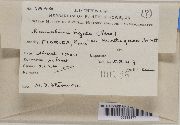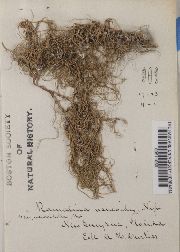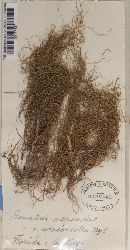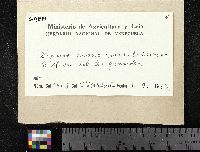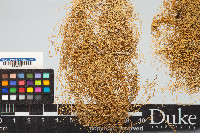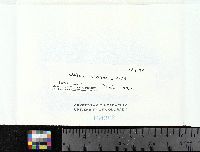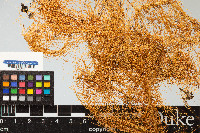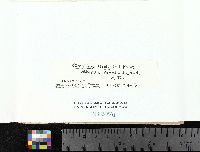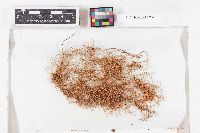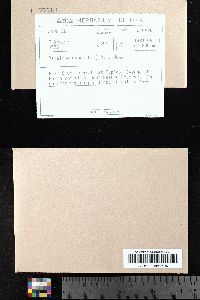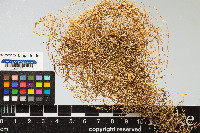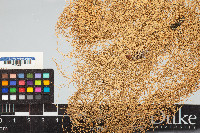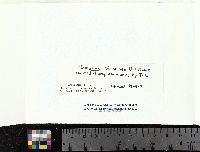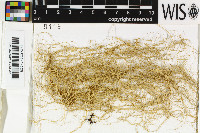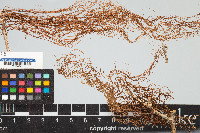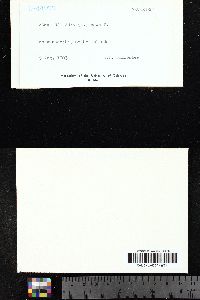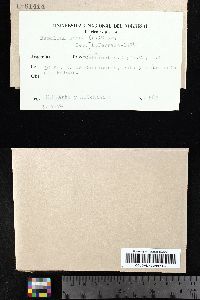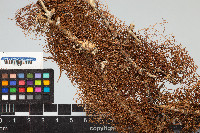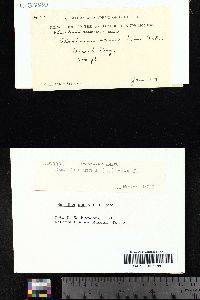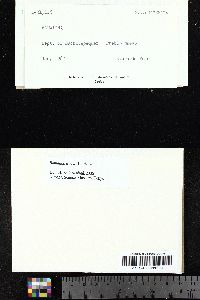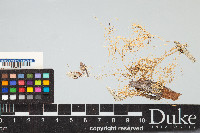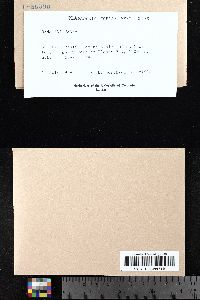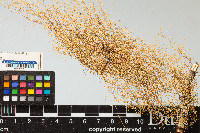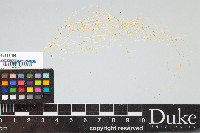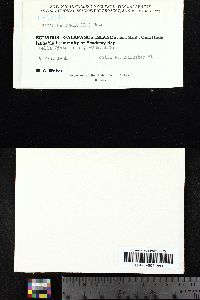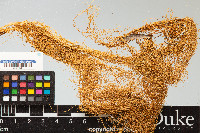
- Home
- Search
- Images
- Species Checklists
- US States: O-Z >
- US National Parks
- Central America
- South America
- US National Parks
- Southern Subpolar Region
|
|
|
|
Family: Ramalinaceae
[Alectoria usneoides (Ach.) Ach., moreLichen usnea L., Parmelia usneoides Ach., Ramalina usneoides (Ach.) Mont., Ramalina usneoides var. usneoides Mont.] |
Bryologist 17: 81, fig. 1, pl. 12, figs 1-2 (1914). A pan-American species already reported from the Galapagos by Weber (1986). This is the most abundant lichen on the Galapagos, aptly named for its similarity to long, draping, pendulous Usnea species. The pale green beards of this abundant lichen festoon trees throughout the transition zone, where the arid lowlands merge with the interior mountains, typically between 80–250 m alt. Occasionally specimens may also be found at higher altitudes, where they are, however, less abundant and thus not as conspicuous. The thin, long branches are sometimes twisted, resembling drill-bits and cannot be mistaken for any other species except Ramalina anceps, a taxon which is possibly only a chemotype of R. usnea (see comments there). Selected specimens examined. Ecuador: Galápagos: Española Island, alt. 100 m, S. Itow L-40694 (CAS no. 685185); Fernandina Island, South Fernandina, alt. 610 m, on bark of Bursera graveolens trees, iii 1899, R.E. Snodgrass s.n. (CAS no. 691787); Marchena Island, 20 vi 1899, R.E. Snodgrass s.n. (CAS no. 681273); Isabela Island, Villamil, alt. 150 m, on bark, trunks of trees, 29 viii 1905, A. Stewart 376 (CAS no. 638140); Volcán Alcedo, in the crater, 0˚ 27’ 9” S, 91˚ 6’ 41” W, alt. 780 m, transition zone; mostly Bursera graveolens and dense scrub on uneven lava, on bark, twigs, 07 iii 2006, A. Aptroot 64753 (CDS no. 31328); Marchena Island, 20 vi 1899, R.E. Snodgrass s.n. (CAS no. 681268); Pinzón Island, along the trail going up from Playa Escondida, 0˚ 35’ 58” S, 90˚ 39’ 32” W, arid zone with Prosopis juliflora, Alternanthera filifolia, Maytenus octogona, and Croton scouleri, on bark, twigs, 16 ii 2006, A. Aptroot 64156 (CDS no. 30720); Pinta Island, along the trail up to the summit from the S-coast, 0˚ 33’ 22” N, 90˚ 44’ 34” W, alt. 88 m, arid zone; open woodland of Bursera graveolens and few Opuntia galapageia with an understory of Croton scouleri, Castela galapageia, Waltheria ovata, Lantana peduncularis among Pahoehoe lava, on bark, twigs of Bursera graveolens; sunny, wind- and rain-exposed, 28 ii 2007, F. Bungartz 6007 (CDS no. 33686); San Cristóbal Island, Westküstengebiet, alt. 120 m, im Wald, an Bäumen, 08 x 1932, H.J.F. Schimpff s.n. (CAS no. 212532); Pan de Azúcar, inland from Bahía Sardinas at the NW-coast of the island, 0˚ 43’ 12” S, 89˚ 21’ 14” W, alt. 143 m, arid zone; NE-exposed slope on hill of consolidated tuff with low vegetation, on bark, branches of Bursera graveolens; semi-shaded, wind- and rain-sheltered, 24 iv 2007, F. Bungartz 6450 (CDS no. 34667); Santa Cruz Island, Academy Bay, alt. 140 m, on bark, trunks of trees, 09. xi 1905, A. Stewart 379 (CAS no. 638142); Puerto Ayora, cliff behind CDRS, 0˚ 44’ 30” S, 90˚ 18’ 40” W, alt. 20 m, on bark, twigs, 18 ii 2006, A. Aptroot 64186 (CDS no. 30749); at base of barranco near seismic station on Piscidia, alt. 30 m, 11 iv 1976, W.A. Weber s.n (CDS no. 10828); off the dirt road to Mina Granilla Rojo, 0˚ 37’ 2” S, 90˚ 22’ 6” W, alt. 294 m, transition zone; deciduous forest of Zanthoxylum fagara, Psidium galapageium, Pisonia floribunda, few Bursera graveolens and Cedrela odorata, on bark, twigs of Zanthoxylum fagara, S-exposed; semi-shaded, wind- and rain-sheltered, 21 vi 2006, F. Bungartz 4939 (CDS no. 29152); Santa Fé Island, on dead bushes, 02 x 1905, A. Stewart 378 (CAS no. 638143); Floreana Island, alt. 150 m, on bark of trees, 04. x 1905, A. Stewart 377 (CAS no. 638141); Santiago Island, ca. 5 km inland from the E-coast, ± at the same latitude as Bahía Sullivan, 0˚ 16’ 35” S, 90˚ 37’ 23” W, alt. 172 m, arid zone; plateau of lava flows and boulders with scarce vegetation (Bursera graveolens, Castela galapageia, Mentzelia aspera), on bark, twigs of Clerodendron molle; sunny, wind- and rain-exposed, 18 vii 2006, F. Bungartz 5235 (CDS no. 29450). from: Nash, T.H., Ryan, B.D., Gries, C., Bungartz, F., (eds.) 2004. Lichen Flora of the Greater Sonoran Desert Region. Vol 2. Thallus: fruticose, pendulous, up to 30 cm long branching: subparallel, irregularly or dichotomously branched, growing from a narrow holdfast branches: solid, mostly flat in basal branches, two-edged in distal ones, 1-3 mm wide surface: yellowish green, smooth or conspicuous striation by pseudocyphellae, shiny, without soredia pseudocyphellae: common, laminal or rarely marginal, narrowly linear cortex: thin; chondroid strands: discontinuous, heavily cracked Apothecia: common, stipitate disc: flat to +concave, without white margin; margin: concolorous with the thallus asci: elongate-clavate, 8-spored ascospores: hyaline, 1-septate, narrowly fusiform, 18-25 x 3.5(-4) µm Pycnidia: not observed Spot tests: cortex K-, C-, KC+ yellow, P-; medulla K-, C-, KC-, P- Secondary metabolites: cortex with usnic acid; medulla with sekikaic (major) and homosekikaic acid (major) and 4'-O-methylnorhomosekikaic acid (minor) for Sonoran specimens. Substrate and ecology: on bark World distribution: southern North America, the Caribbean and Central and South America Sonoran distribution: only few collections in Sinaloa, more common in southern states of Mexico at elevations between 800 to 1200 m. Notes: Although several chemical races of R. usnea have been reported (Kashiwadani 1993; Landrón 1972), only sekikaic acid aggregate race are found in the Great Sonoran region. Ramalina usnea resembles R. sharpii Rundel, a species reported from Hidalgo, Mexico, that differs in having smooth chondroid strands, broadly fusiform ascospores and norstictic acid. Ramalina usnea might be confused with R. menziesii that differs in having fenestrate branches and in lacking medullary chemical metabolites. It also resembles one morphology of R. alludens with marginal, continuous pseudocyphellae. However, it can be distinguished by its narrowly linear pseudocyphellae and by its narrowly fusiform ascospores; R. alludens has broadly fusiform ascospores. |

![Ramalina usnea (L.) R. Howe [Bungartz, F. 5235 (CDS 29450)] Ramalina usnea image](/imglib/lichens/CDS_Lichens/00029/CDS_29450_DX_1102_print_1555629784.jpg)

